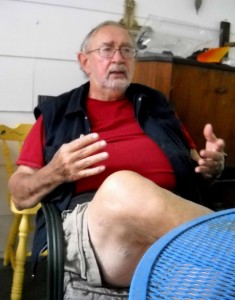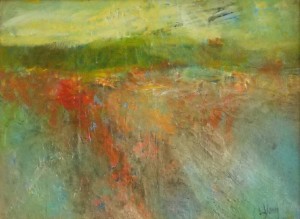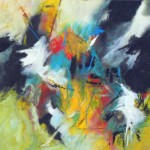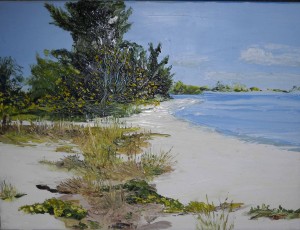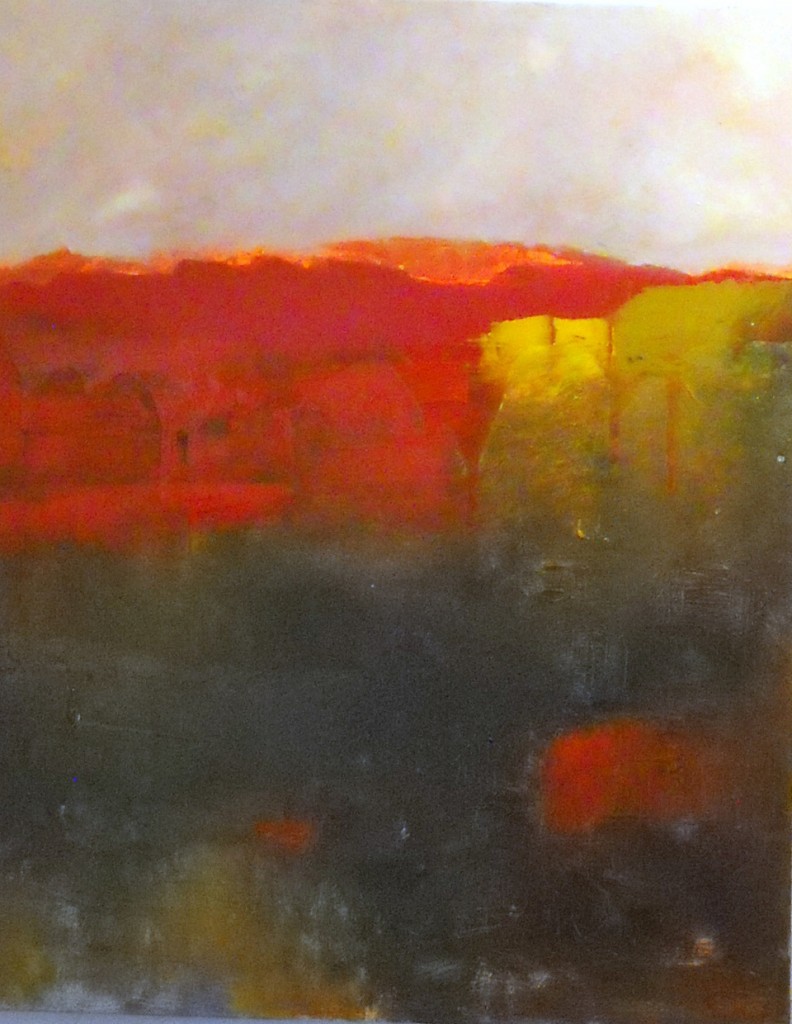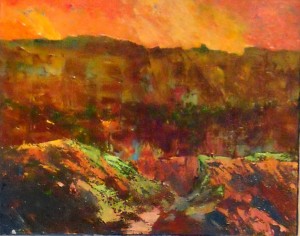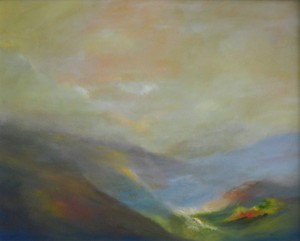For interviews with other painters see: Ellyn Bivin / Josiah Golson / David Jones / James McKissic / Renel Plouffe / James Tucker
“When I’m working in the studio, I listen to classical music and just let the art come out. How do you plan something like that?” Larry Young gestures to the painting hanging on the wall behind him, “It has to be spontaneous.” It is emotion, he says, that drives his art; it is feeling revealed in form and color that he is after.
Larry has traveled a long and interesting road to get to this late career as an artist. As a boy, he loved to use crayons in his Lone Ranger coloring book, content to stay neatly between the lines, but using color freely, usually analogous colors. He liked the different harmonies he could make and never worried if the picture looked ‘real’. Though he enjoyed his art courses in high school and took introductory drawing and painting courses at the University of Tennessee – Knoxville, he ultimately majored in political science. Upon graduation he went to law school and became a prosecutor. During these years he was only able to paint sporadically. “I was often in court and the work was intense. Besides, it’s hard to feel creative after dealing with the worst elements of society and their victims day after day.” But the desire to make art was never entirely eclipsed, and upon his retirement he enrolled at the University of Tennessee – Chattanooga and took all the drawing and painting courses available. Today he is an active and prolific artist.
His studio is a narrow room, almost a hallway, and his easel is set up directly on a wall. It is a space with no pretensions or decoration. A bit cluttered, it is a place that encourages work. There are tubes of paint in drawers and on a nearby counter beside a stack of Styrofoam plates. Larry primarily paints in acrylic these days and uses the plates as disposable palettes. It is a work space pure and simple, so there is no need to worry about making a mess. “That’s where I was spray painting,” Larry says with a laugh as he points to the colored streaks on the wall. The arrangement suits him. It is a studio that encourages the freedom and spontaneity that are at the center of his creative process and abstract aesthetic.
A Gallery of Paintings by Larry Young
- Meander
- Valhalla No. 1
- Seascape
- Valahalla No. 2
- Storm Fire
- Germination
However, such freedom and spontaneity is hardly the random painting of a novice. It is the product of years of study and reflection: years of thinking about both his work and that of others. In addition to his many visits to museums over the years, Larry is a thoughtful student of art history, and his knowledge of twentieth century art is considerable. His art library boasts over 100 books. It is this learning, coupled with his studio training, which lies at the heart of his approach to painting.
“Artists have a wealth of internal information that comes out as they work. It’s all stored inside, everything – all their training, all their reading, and all their experiences. The reason painters, abstract painters, can just let go is that this information is there and you can communicate it. Without that, you’re just blindly pushing paint and hoping for the best.”
As Larry has developed as an artist, he’s experimented with many styles, trying them on as another man might try on hats. Stacked against the wall in an upstairs storage area are figure studies he’s done from life drawing classes and landscape paintings done plein air.
These experiments were an essential part in the process of finding his natural mode of expression, an abstract approach, which he finds more satisfying than a more representational style of painting. Having moved beyond a realist aesthetic, he now focuses his efforts on loosely interpreted atmospheric landscapes as well as completely non-representational work. Both approaches rely on his deft use of color, sense of composition, and vigorous brushwork for their impact.
He often starts a painting by choosing a palette of colors that reflects his mood – subtle earth colors and smoky grays or perhaps more vibrant colors like bright orange and black. These colors then become like the key signature a musical composer would use –they establish mood and atmosphere. Lately Larry has been softening his colors with gesso, its weak tinting strength allowing a more subtle use of color.
As he approaches the blank canvas he only has a general idea in mind. “Some idea stimulates me and I just start. It’s often a small thing, a shape or color, or it could be something I’ve seen,” he says. “For instance, the sky over Signal Mountain sometimes has an unusual coral color. I don’t suppose many people notice that.” That is exactly the sort of thing Larry does notice and catalogues in his memory. As he goes through each day, he’s painting in his mind, imagining how he would react artistically to the world he sees around him.
His method of working then becomes a dialogue between himself and the canvas—a dynamic exchange that emerges as paint is applied and changes are made. He is continually reacting to what he sees and feels as the image evolves.
“I can’t plan this way of working, but I can be conventional insofar as I need to be conventional. There are always concerns about the relationships of colors, composition, that sort of thing. Really, that’s where training and instinct come in. I’ll back off and see things I like and also see things I don’t like, things that don’t quite look right. Then it’s a matter of touching up, making smaller and smaller adjustments until the painting holds together and I feel it expresses what I want. Each one of my paintings represents an emotional point in time for me. I doubt I could repeat one because I wouldn’t be exactly the same person.”
In the process of creating a painting he concerns himself not just with the surface but also with the creation of a sense of depth. “When you paint in oil you usually work into the wet paint. When you work in acrylic you often work onto the paint since acrylic dries so fast.” By continually building layers of paint, wet over dry, he is able to invite the viewer to see into the work, rather than have their eye remain only on the surface.
Though a sense of depth is important to his art, Larry was very much influenced by artists like Mondrian and color field painters who often chose to paint geometric shapes in flat color. Indeed, the whole trajectory of modern art from Cezanne up through color field painters like Albers, Rothko, and Reinhardt fascinates him. “You know I’ve looked at some of Reinhardt’s all black paintings so long and carefully that I actually can tell a difference between them.”
Once a painting has reached a satisfactory point, Larry likes to hang the work for a while and think about it, letting his judgment of its worth mature. Over time he may or may not make additional changes. Sometimes the changes are extensive and some of his paintings have a sort of history to them as layers of paint and new ideas are introduced. However, whether the changes are many or few, eventually the point is reached when the painting needs no further work and can be exhibited.
“My art is personal and I guess you could say I paint for myself, but I’ve enjoyed showing my work at The Northshore Gallery of Contemporary Art and meeting people at the receptions. Embracing the more public aspect of being an artist has meant a lot to me.”
Return to Interviews with Artists
